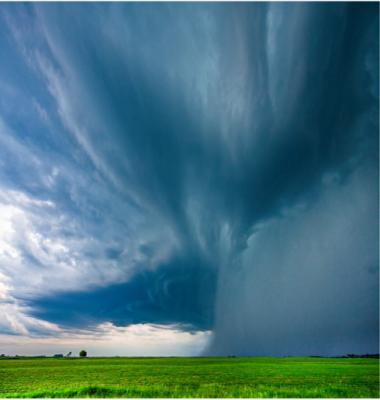Central U.S. Summer Rainfall Affected by Early Warm-Season Mesoscale Convective Systems
Soil moisture can significantly influence precipitation through soil moisture–precipitation feedback. Previous studies of soil moisture–precipitation feedback focused on total precipitation, ignoring the roles of different convective storm types. In the central United States (U.S.) where mesoscale convective systems (MCSs) contribute 30% to 70% of warm-season rainfall, researchers used unique datasets of MCS and non-MCS rain as well as soil moisture resulting from each type of rain. Their analyses revealed the dominant role of early warm-season (April–June) MCS rainfall in summer (July) MCS and non-MCS rainfall. The results underscore the critical role of early warm-season MCSs in providing predictability for summer rainfall in the central U.S.
The central U.S. is a major grain-growing region. Predicting summer rainfall has important agricultural implications. These results indicate that MCS rainfall in April–June may influence the spatial distribution and amount of MCS and non-MCS rainfall in July. This potentially provides a source of predictability for summer rainfall at subseasonal-to-seasonal timescales. The critical role of early warm-season MCSs underscores the importance of representing MCSs in climate models, which may alleviate the model biases in simulating summer rainfall in the central U.S.
Land–atmosphere interactions play an important role in summer rainfall in the central U.S., where MCSs contribute to 30–70% of warm-season rainfall. Previous studies of soil moisture–precipitation feedbacks focused on total precipitation, confounding the distinct roles of different convective storm types in rainfall. Researchers recently investigated the soil moisture–precipitation feedbacks associated with MCS and non-MCS rainfall as well as their surface hydrological footprints. They used a unique combination of observed MCS and non-MCS rainfall and land surface simulations with numerical tracers to quantify soil moisture sourced from MCS and non-MCS rainfall. Researchers found that early warm-season (April–June) MCS rainfall, characterized by higher intensity and larger storm area, produces mesoscale spatial patterns of soil moisture that are important for initiating the summer (July) afternoon rainfall dominated by non-MCS events. Additionally, soil moisture sourced from both early warm-season MCS and non-MCS rainfall contributes to the lower-level atmospheric moistening favorable for nighttime upscale MCS growth. However, with higher intensity, MCS rainfall percolates deeper in the soil than non-MCS rainfall. Therefore, the soil moisture anomalies from MCS rainfall can last longer and contribute more to July MCS rainfall. Therefore, early warm-season MCS rainfall dominates soil moisture–precipitation feedback.

